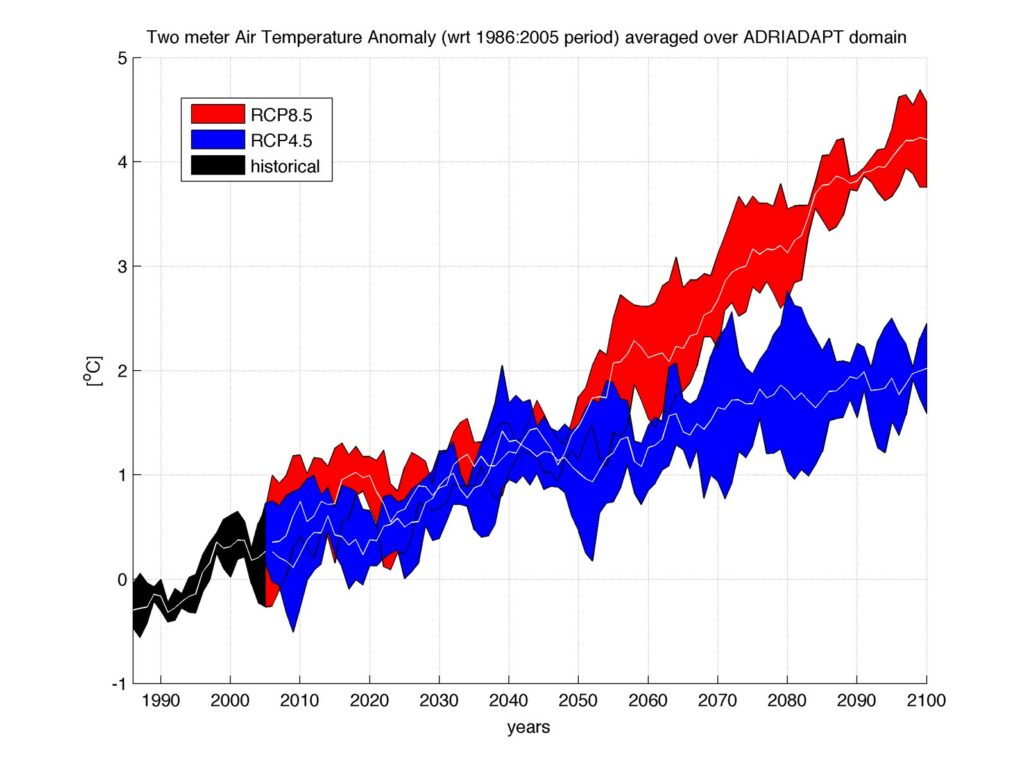Climate Information

Short summary of climate data and projections
Climate data and projections produced within the ADRIADAPT project cover the period from 1986 to 2100, following historical forcing up to 2005 and two different future emission scenarios: a moderate one (RCP4.5), which includes a future world where considerable efforts have been put into mitigation policies, and a high-emissions one (RCP8.5) that includes a future world without climate mitigation policies.
Simulations were made over the ADRIADAPT domain, which runs along the northern coast of Italy and a great part of the Croatian coast, and for the local (city) level in pilot sites. Simulations are presented as changes with respect to the present situation (baseline 1986-2005) for different future periods: 2021-2040, 2041-2060, 2061-2080, 2081-2100 and as trends for the whole period from 2021 to 2100. The changes are shown for selected climate indices, such as: extreme temperature and precipitation, and combined indices based on humidity and wind with impact on population and the territory. All projections have been made using Regional Climate Models and Statistical Downscaling Models.
Common key messages of ADRIADAPT
- An increase in seasonal and annual mean air temperature is expected by 2100, with the strongest changes projected to occur during summer. Increases of mean temperature by 2°C for RCP4.5 and 4.5°C for RCP8.5 could be reached by the end of the century.
- An increase in both maximum and minimum air temperature is expected by 2100; the annual maximum temperature is expected to increase more than annual minimum temperature. Changes of up to 3.3°C for RCP4.5 and 6.5°C for RCP8.5 are expected to occur for annual maximum temperature by the end of the century.
- A shift of the entire distribution of minimum and maximum air temperature to warmer values is projected to occur during all seasons, with peak intensity during the summer.
- A decrease in the number of frost days is projected to occur during winter, spring and autumn; pronounced decreases are expected over the plains and locally with the tendency towards the complete disappearance of frost days, especially for RCP8.5 and towards the end of century. During winter, when frost days are most common, the expected change in the middle of the century is about 7.5 fewer days per season (December to February) than the base line period when up to 30 frost days are expected, for both emission scenarios. At the end of century, RCP4.5 projects around 12.5 fewer days, whereas the RCP8.5 scenario projects even 25 fewer frost days than in the baseline period; locally the signal could be more intense.
- An increase is expected in the seasonal heat wave duration, for both emission scenarios, over the whole region by 2100. The peak signals are in the urban areas of the pilots, especially during the summer season.
- Also, the number and intensity of tropical nights is expected to increase in the entire domain, with high intensity in the urban areas, especially during summer (June to August). The projections indicate a possible increase of about 20 tropical nights for RCP4.5 and 30 tropical nights for RCP8.5 by the end of the century, more than doubling the baseline value; locally the projected changes could be more intense.
- Projections of precipitation amounts are not homogeneous over the entire domain. Common features could be summarised as follows: the signal of projected changes is very small in winter for the moderate emission scenario (RCP4.5), whereas a slight increase of precipitation could occur for the northerneast part of domain for the high emission scenario (RCP8.5); summer precipitation is projected to decrease, more by the end of century.
- Projection of intense and extreme precipitation follow the signal of change for total precipitation. During winter, intense precipitation will increase most for RCP8.5 – along the eastern side of the Adriatic (but also inland Croatia) by about 4mmday-1 and about 10 mmday-1 over mountainous area. The opposite signal can be expected during summer when the decrease of intense precipitation will be up to 4 mmday-1 along the eastern part of the Adriatic coast and inland in the southern part of Italy, considered in the domain for RCP8.5. Extreme precipitation in summer does not show the clear pattern of change for either scenario.
- An increase in the maximum number of consecutive dry days is projected to occur, with a peak in the summer season.
